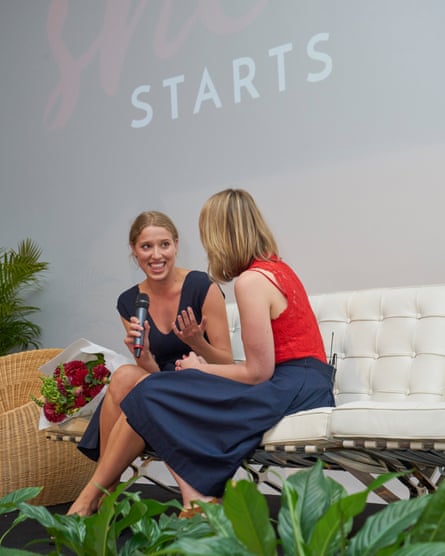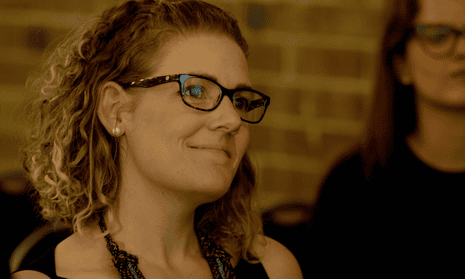Technology has a solution for just about every modern problem, from guiding a visually impaired person around an unknown city to exploding the information bubble we all live in. And if Nicola Hazell has her way, it could also remedy the lack of women at the helm of ASX 200 companies.
Hazell is the director of SheStarts, a new startup program aimed at female tech entrepreneurs, announced last year. After a flood of applications, 10 founders were selected to receive $100,000 seed funding and a place in the program. Now SheStarts has launched a web series that follows the women as they bring their idea to life.
These women are from diverse backgrounds: different age groups, different career experiences, from regional and urban areas around Australia. Some are softly spoken, some straight talkers, yet all the founders are passionate about the tech solutions they have come up with.
Indeed, it’s fascinating to see what gets them going: Lauren Meyer barely draws breath when she talks about her and co-founder Madeline Green’s plan (Shark Share) to create a virtual tissue bank for research scientists, Naomi Stuart (Farmpay) gets excited about overhauling farm financing and Sally Coldham (Airloom) is thinking about what happens to our social media after we die. Claire Jenkins has come up with a clever way to solve pet health issues without leaving the house (Vetchat) while Xiano Han Drummond (Refni) wants to explode the information bubble we all live in.
Often it’s their own experience with these problems that inspired the solution. Anna Wright’s diminishing eyesight got her thinking about how those who are visually impaired navigate a city as well as a smartphone solution (Audible).
There aren’t many Australian startup funds reserved solely for women: Springboard Enterprises is the most visible one. SheStarts is backed by Blue Chilli, one of the foremost accelerator programs in Australia, and is aimed at the tech industry because of the lack of women employed in this field. Men outnumber women two to one in key tech roles, particularly in key coding roles, according to a report released by Davidson Technology in June 2016.
Similarly, despite the fact that Australia ranks second in the world for its support of high-impact women’s entrepreneurship, SheStart’s own research found a dearth of female entrepreneurs in Australia: fewer than one in four startups are led by women, and, of those attracting investment, only 4%.

Equally, as Hazell is fond of pointing out, there are more CEOs named Peter than female CEOs at the helm of ASX 200 companies. She sees a link between the lack of women in tech and those at the top. “If we want to see more women at the helm of ASX 200 companies, then we need to get them at the helm of companies that are the future ASX 200 companies,” she said at the finalists’ event in December. “There is no denying that innovation, the creative intersection of human creativity and tech, that creates incredible global companies, [is] where we need to focus our attention right now, that’s where we see that change happening.”
Many of the founders felt perceptions around being female have held them back. After a lengthy career in software development, Emma Popska has come up with a solution to reclaiming data privacy with Brontech. Yet despite her experience, she’s often been confronted by sexism.
“Nobody wants to say it aloud, but it is a common misconception that women are not as good as men in tech,” she says. “The only reason for that is that this doesn’t fit our expectations of what a typical tech entrepreneur is.
“It’s time to debunk the stereotype that guys in hoodies are the only ones that know how to write good code.”
Similarly Jessica Christiansen-Franks, one of the founders behind Neighbourlytics says: “People pat me on the back for being a female CEO – this is incredibly patronising.”
This is just part of the reality of being a female entrepreneur, says Carla Harris, founder of Longevity, an app that helps to increase superannuation contributions. “Last night, for instance, I was having dinner with a male 40-something family friend. He congratulated me on my success in SheStarts, and then repeatedly complained about the fact that it was discriminatory because it was only open to women. Even in jest, those kinds of comments demonstrate where our social consciousness is at.
“I wondered if he had considered the preferential treatment that he’s had his entire life as a white male. That’s the reality of the playing field.”
Despite the obstacles, some of the founders felt they would draw on typically female strengths such as the ability to collaborate, make connections and ask for help when needed. “Women’s networking events and Facebook groups have a somewhat unique tone, a spirit of community and connectedness – and also of problem solving – a commitment that we’re going to work this out, together,” says Georgina Bird, founder of financial literacy app Honey.
And a tendency to want to perfect every last detail could be helpful, rather than a hindrance. “Women tend to be more risk-averse and do an extensive due diligence before making any decision,” Popska says. “Although this seems counterintuitive as society portrays entrepreneurs as risk takers, I argue that running a business is more about risk management than the risk itself.
“In a fast-paced and volatile environment [such] as the tech industry, limiting the uncertainty to a manageable level is essential predisposition for the company survival on the long run.”
All believe their visibility as female tech entrepreneurs is essential to inspire those who come up after them. “When you walk by a row of business or tech magazines and only see middle-age men in fancy suits on the cover, it makes it hard to see a space for yourself within the industry,” Meyer says. “And if there is any little girl who cannot envision herself as whatever she wants to be, we are limiting half of the world’s potential.”

Comments (…)
Sign in or create your Guardian account to join the discussion